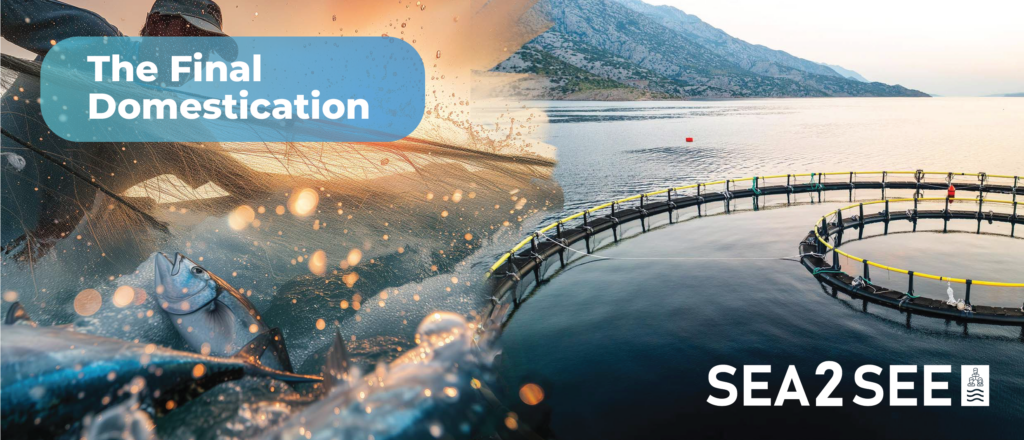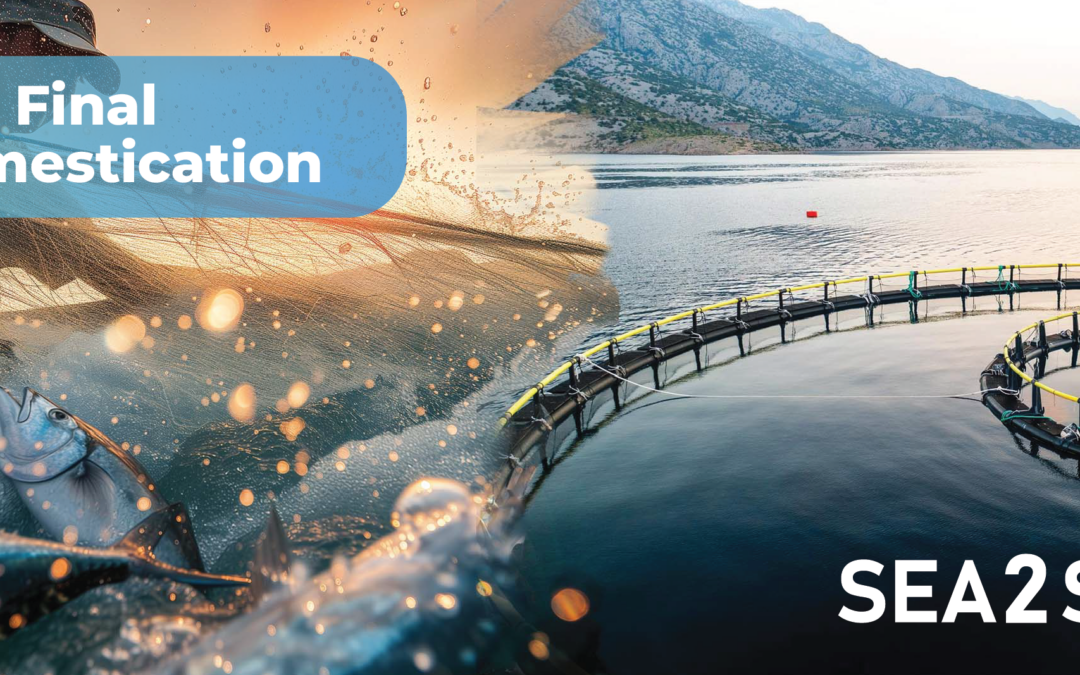
It’s late in the afternoon any given Friday, and we forgot we had friends for dinner. We would not go to our local market to buy a pheasant or some wild boar chops to prepare in a hurry. We find the natural thing to do, to go and choose from the several choices of chicken and pork cuts, and their different qualities, from regularly produced to free range, to organic. Yet….we still hesitate when we are looking for fish?
The history of humankind is marked by a series of transformative milestones, from the domestication of plants and animals to the industrial revolution. Today, as global populations rise and demand for sustainable food sources grows, we stand on the brink of another crucial transformation: the final domestication—aquaculture. This practice, which involves cultivating aquatic organisms like fish, shellfish, algae, and other marine species, is revolutionizing the way we produce protein and respond to the world’s food needs.
The Evolution of Aquaculture: From Ancient Practice to Modern Necessity
The domestication of fish is a fascinating process that has evolved significantly over the course of history. Unlike the domestication of land animals, which began over 10,000 years ago with species like dogs, cattle and sheep, the process of taming and cultivating seafood is a relatively recent phenomenon in human history, becoming more structured and systematic only in the past few centuries.
Back in 3 500 BC, in Ancient China we find some of the earliest recorded instances of fish farming, where carp were raised in ponds. The Chinese philosopher Fan Li, wrote in the 5th century BC a treatise on fish farming called the “Fish-Breeding Classic,” which is one of the oldest manuals on aquaculture. Carp was a popular species due to its hardiness and ability to thrive in various conditions. Early Chinese farmers developed techniques to breed and manage carp populations, laying the groundwork for modern aquaculture practices.
In ancient Egypt, around 2 500 BC, hieroglyphic records suggest that tilapia were cultivated in ponds. Tilapia farming played a role in the Egyptian diet and was an important source of protein, as fish could be farmed year-round. Fish ponds were often located near the Nile River, taking advantage of its waters for controlled fish breeding and management.
Around 100 BC – 400 BC, the Romans developed sophisticated fish farming techniques, particularly for species like trout and mullet. They built structures called “vivaria,” which were enclosures that allowed them to breed and grow fish in controlled environments. The Romans were also skilled in creating artificial lakes and ponds where they managed fish populations, including high-value species like sturgeon, used for producing caviar.
Fish domestication in Hawaii has a unique and ancient history that is deeply intertwined with the culture, traditions and sustainability practices of the Native Hawaiian people. The indigenous Hawaiians developed sophisticated aquaculture systems long before Western influence, creating one of the earliest and most successful methods of fish farming in the Pacific. This tradition centered on the construction and use of fishponds, known as loko i‘a, which played a crucial role in both food production and ecosystem management. Some of these structures appear to be some 1 500 – 1 800 years old. Fishponds were more than just a food source. They were part of the Hawaiian way of life, symbolizing their deep understanding and respect for their natural environment.
The Science Behind Domestication
In 18th Century Europe, the idea of systematic fish farming began to resurface, especially in countries like Austria and France. Fish hatcheries were developed to improve the breeding of species like trout and salmon, aiming for greater control over reproduction.
The industrial revolution brought technological innovations that significantly advanced the farming of seafood. Scientists began to study fish biology, feeding habits and breeding processes in more detail. In the mid-19th century, controlled fertilization of fish eggs became more common, allowing for the deliberate reproduction of species like salmon and trout, which became essential to aquaculture practices.
Traditional animal domestication, like cattle, pigs and chickens, took centuries of selective breeding to enhance desirable traits such as growth rates, behavior and disease resilience. Aquaculture is rapidly catching up to these achievements but within a much shorter timeframe owing to modern technological innovations.
For example, salmon, tilapia and shrimp have been selectively bred to grow more efficiently and require fewer inputs while yielding higher outputs, making them more sustainable and cost-effective.
One of the most exciting aspects of aquaculture’s evolution is the integration of advanced technologies. Companies like Smartwater Planet S.L. are leading the way with innovative solutions such as multiparametric sensor platforms and AI-driven data analytics. Devices like MEDUSA, an IoT-enabled water quality monitoring system, provide real-time insights into aquatic environments, optimizing conditions for fish growth and health.
Artificial Intelligence (AI) and machine learning play crucial roles in predictive analysis, enabling farmers to anticipate changes in water conditions, fish behavior, and feeding patterns. These technologies reduce the risk of disease outbreaks and environmental stress, leading to more resilient and productive aquaculture systems.
Moreover, projects like Sea2See apply co-creation tools and blockchain technology to ensure traceability and transparency throughout the supply chain, guaranteeing that consumers have access to safe, sustainable and responsibly sourced seafood. The integration of satellite imaging and remote sensing further enhances monitoring capabilities, allowing aquaculture facilities to track environmental changes and mitigate risks in real time.
Challenges and Ethical Considerations in Fish Domestication
Despite its progress, the domestication of fish is not without its challenges. We need to learn the history from our previous experiences as “domesticators” and pay attention to vital issues such as minimising environmental impact, maintaining genetic diversity and providing for animal welfare. Hence, the future of fish domestication will likely focus on sustainability and resilience:
- Breeding Programs: There is a growing emphasis on developing families of fish that are more resistant to diseases, have better growth rates, and consume less feed.
- Sustainable Practices: Innovations like integrated multi-trophic aquaculture (IMTA) and the use of plant-based feeds aim to reduce the environmental impact of fish farming.
- Technological Advances: With the integration of AI and machine learning, fish farming is becoming more data-driven, enabling more precise management and reducing waste.
Sustainability: Aquaculture’s Biggest Challenge and Opportunity
While aquaculture holds tremendous promise, it also faces significant challenges related to sustainability and environmental impact. Issues like water use, habitat displacement and the regulation of health practices in fish farming are main points of care.
However, these challenges are driving innovation. The shift towards recirculating aquaculture systems (RAS) and integrated multi-trophic aquaculture (IMTA) is reducing the environmental footprint of fish farming. RAS allows for closed-loop systems that recycle water, minimizing waste and preventing pollutants from entering natural ecosystems. IMTA combines different species — such as fish, shellfish and algae — within the same environment, creating a balanced ecosystem where the by-products of one species serve as inputs for another.
Sustainable feed alternatives are also being explored, such as insect-based proteins, algae and other plant-based ingredients, to replace traditional fishmeal and fish oil, which are often sourced from wild-caught species. These innovations aim to make aquaculture not only more sustainable but also more economically viable.
The Final Domestication: What It Means for Global Food Security
Aquaculture represents the final frontier in humanity’s effort to domesticate food sources. As our ability to cultivate aquatic species becomes more refined, we are redefining what it means to produce protein in the 21st century. With the global population projected to reach 9.7 billion by 2050, aquaculture is poised to play a critical role in achieving food security and reducing hunger worldwide.
The United Nations’ Sustainable Development Goals (SDGs) underscore the importance of sustainable food production and aquaculture aligns with many of these objectives. It has the potential to deliver nutritious food, create economic opportunities in coastal and rural areas and contribute to environmental conservation efforts when managed responsibly.
The Future of Aquaculture: Collaboration and Innovation
What makes modern aquaculture different from its ancient predecessors is its scale and technological advancement. Today, aquaculture is the fastest-growing food production sector in the world, providing more than 50% of the fish consumed globally. As wild fish stocks decline due to overfishing, habitat loss and climate change, aquaculture has emerged as a necessary alternative to meet the rising demand for seafood while reducing pressure on natural ecosystems.
The future of aquaculture depends on continued innovation and international collaboration. Like in the case of the Sea2See project, public-private partnerships, research initiatives and cross-sectoral cooperation will be essential in driving the industry forward. For companies like Smartwater Planet, this means staying at the cutting edge of technology and engaging in projects that promote sustainable aquaculture practices and environmental stewardship.
By harnessing the power of technology, data and sustainable practices, we are unlocking the full potential of aquatic species to meet the growing global demand for food. As we look to the future, aquaculture stands as a beacon of hope, symbolizing our ability to adapt, innovate and cultivate a more sustainable world.
Aquaculture’s journey is still in its early stages compared to the domestication of terrestrial animals but its trajectory is clear. With the right balance of innovation, sustainability and global cooperation, aquaculture can indeed become the final domestication — offering a reliable, scalable and eco-friendly solution to feeding the world.
Contributor: Smartwater Planet

